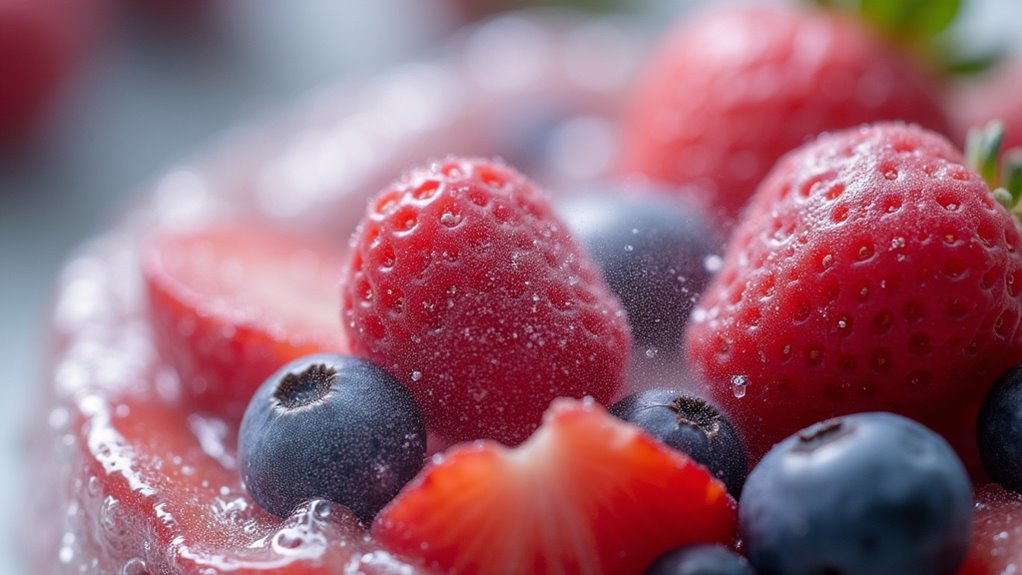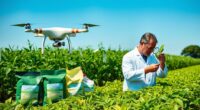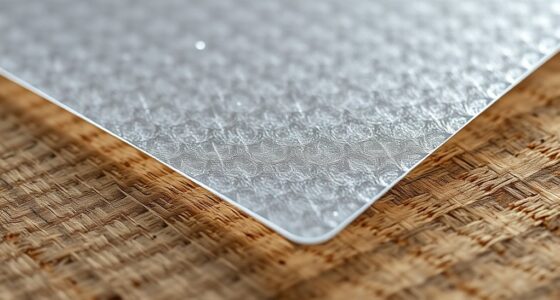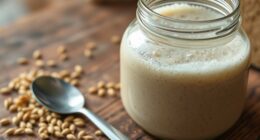Edible packaging combines natural biopolymers like proteins, polysaccharides, and lipids to form safe, biodegradable films that protect food. These materials act as barriers against oxygen, moisture, and grease, extending shelf life. Techniques like casting and extrusion create thin, durable films, while additives such as essential oils provide antimicrobial benefits. If you explore further, you’ll discover how innovations are making edible packaging more effective, sustainable, and suited for future food preservation solutions.
Key Takeaways
- Edible packaging materials are composed of biopolymers like polysaccharides, proteins, and lipids, which provide structural integrity and barrier properties.
- Natural plasticizers and cross-linking agents modify flexibility and strength, enhancing functional stability of edible films.
- Barrier functionalities against oxygen, water vapor, and grease are achieved through multilayer structures and incorporation of lipids or waxes.
- Production techniques such as solvent casting, extrusion, and spray coating tailor film properties for specific food protection needs.
- Incorporating natural extracts and secondary compounds imparts antimicrobial and antioxidant properties, extending shelf life and ensuring safety.
The Chemistry Behind Edible Packaging Materials
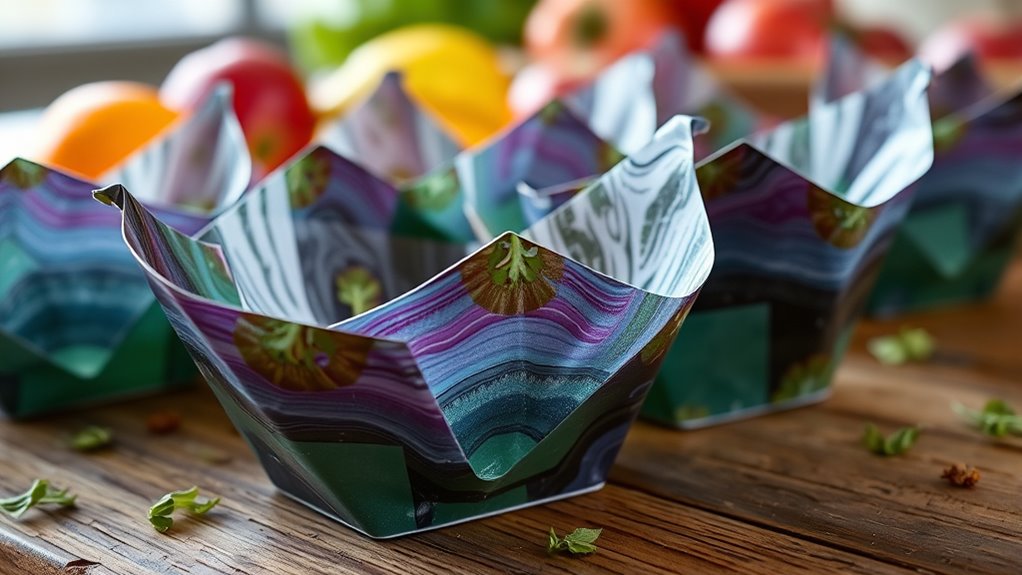
The chemistry behind edible packaging materials relies on a combination of natural biopolymers and additives that work together to create functional, safe, and biodegradable films. Polysaccharides like alginate, derived from seaweed, cornstarch, and sugarcane, form the structural backbone and provide oxygen barriers. Proteins from animal or plant tissues, such as milk or grains, can be modified through heat, pH, or enzymatic treatments to enhance their properties. Lipids add hydrophobic qualities, boosting moisture resistance, especially when combined with hydrophilic polymers. Natural plasticizers like glycerol or sorbitol improve flexibility and reduce brittleness. Cross-linking agents, such as calcium ions, strengthen the films via ionic bonds. These components and their interactions are key to creating effective edible packaging solutions. Additionally, advancements in biodegradable technology have facilitated the development of more sustainable and environmentally friendly packaging options.
Key Components and Their Functional Roles
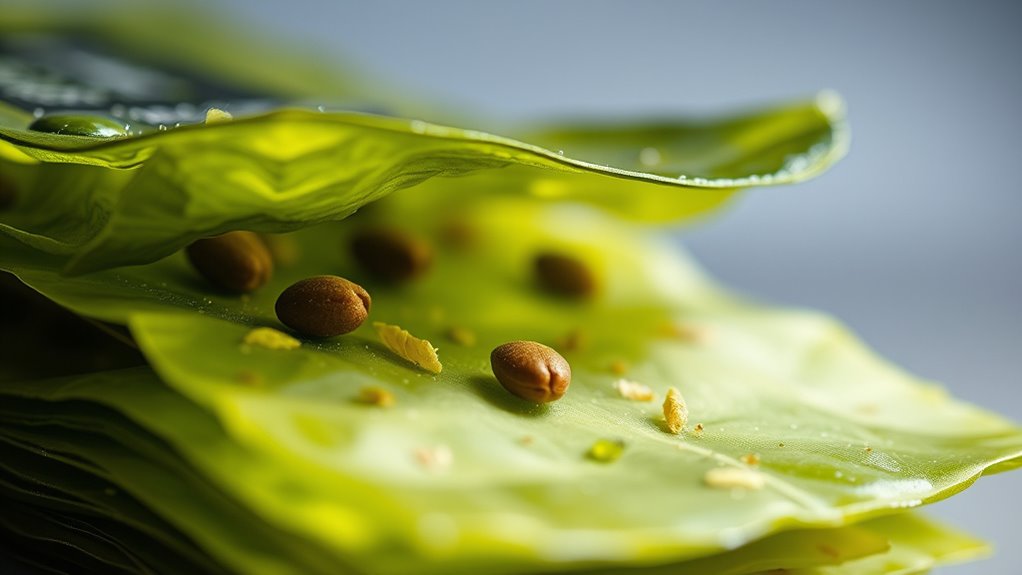
Understanding the key components of edible packaging reveals how each material contributes specific functional roles. Food-grade ingredients like seaweed, starches, gelatin, and fruit extracts form the base, providing safety and edibility. These natural ingredients are biodegradable and sourced sustainably, making them environmentally friendly options. Biopolymers such as proteins, polysaccharides, and lipids create flexible films and coatings that protect food and provide structural support. Secondary compounds like essential oils and phenolics enhance antimicrobial properties, helping extend shelf life. Beeswax adds moisture resistance and barrier qualities, preventing spoilage and dehydration. Gelatin offers strength and integrity, ensuring durability during handling. Innovative formulation techniques work to optimize the functionality and stability of these edible materials. These components work together to form versatile, biodegradable packaging that safeguards food, preserves flavor, and reduces waste—all while offering nutritional benefits if desired.
Barrier Properties and How They Protect Food
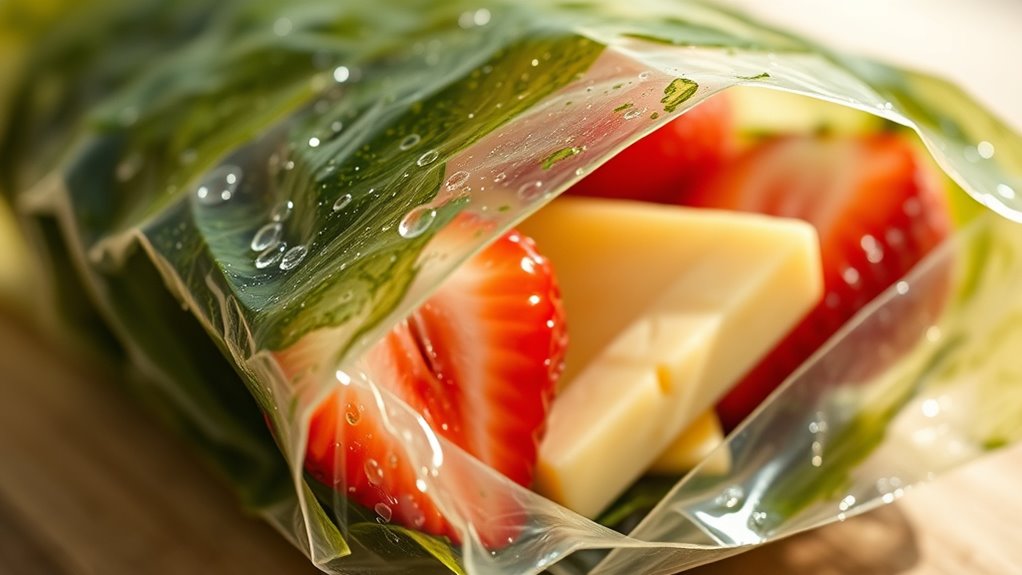
Edible packaging materials like alginate, gellan gum, wax, chitosan, and pectin create effective barriers against oxygen, water, and grease, helping to keep food fresh and safe. These barriers control moisture loss and gas exchange, extending shelf life and preserving flavor. Multilayer and layered biodegradable packaging structures can further enhance barrier performance by combining different materials tailored to specific food protection needs. They reduce oxygen, carbon monoxide, and ethylene permeation, which helps prevent spoilage and nutrient loss. UV light protection minimizes nutrient degradation and off-flavors caused by light exposure. Barrier properties also shield food from mechanical damage like dents or cuts. Water vapor barriers prevent dehydration, while gas barriers regulate oxygen and carbon dioxide levels, slowing ripening and microbial growth. Grease resistance maintains product integrity, especially for fatty foods. Additionally, barrier properties are crucial in reducing the need for synthetic preservatives, aligning with sustainability goals. Overall, these barrier properties are essential in maintaining quality and safety throughout storage and display.
Production Techniques for Edible Films and Membranes

Production techniques for edible films and membranes encompass various methods that transform biopolymers into functional food packaging. Solvent casting involves dissolving biopolymers like starch or cellulose in water or solvents, pouring the solution onto molds, and drying to form uniform, thin films. This method is ideal for hydrophilic materials but requires careful mold design to prevent peeling. Solvent casting is one of the most widely used techniques due to its simplicity and ability to produce films with good clarity and uniformity. Additionally, controlling drying conditions can influence the film’s mechanical properties and barrier performance. Compression molding uses heat and pressure to shape thermoplastic biopolymer mixtures, producing sturdy films suitable for large-scale production. Extrusion melts biopolymers and pushes them through dies, creating continuous sheets that can include additives like antimicrobials. Extrusion offers high scalability and efficiency for industrial applications. Spray coating applies film-forming solutions directly onto food surfaces, allowing quick, uniform coverage. Hybrid approaches combine materials like hydrocolloids and lipids via casting or lamination, enabling tailored properties for specific packaging needs.
Innovations in Edible Packaging for Food Preservation
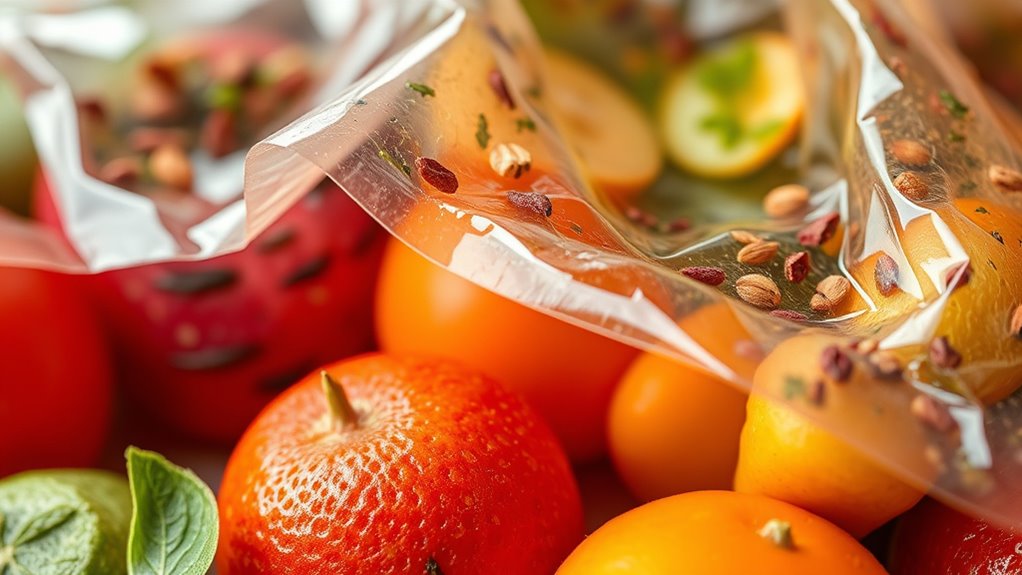
Innovations in edible packaging are transforming how we preserve food by combining sustainability with functional benefits. You can now find biodegradable materials like plant fibers, algae, and starches that not only reduce environmental impact but also extend shelf life. Embracing sustainability in the food manufacturing industry drives the development of these innovative solutions, ensuring that environmental considerations are integrated into product design. Seaweed, wheat, and other renewable resources are increasingly used for their abundance and eco-friendliness. Dairy-based films made from milk proteins like casein and whey offer superior oxygen barriers, helping prevent spoilage. Plant proteins inspired by spider silk provide strong, biodegradable options. Edible starch films, safe for consumption, are another sustainable solution. These innovations also incorporate antimicrobial properties and moisture control, which inhibit microbial growth and keep food fresh longer. Additionally, biodegradable packaging materials are being engineered to degrade rapidly in various environments, reducing waste accumulation. Overall, these advancements make edible packaging more effective, eco-friendly, and aligned with consumer demand for sustainable food preservation methods.
Challenges in Developing Durable Edible Packaging Solutions
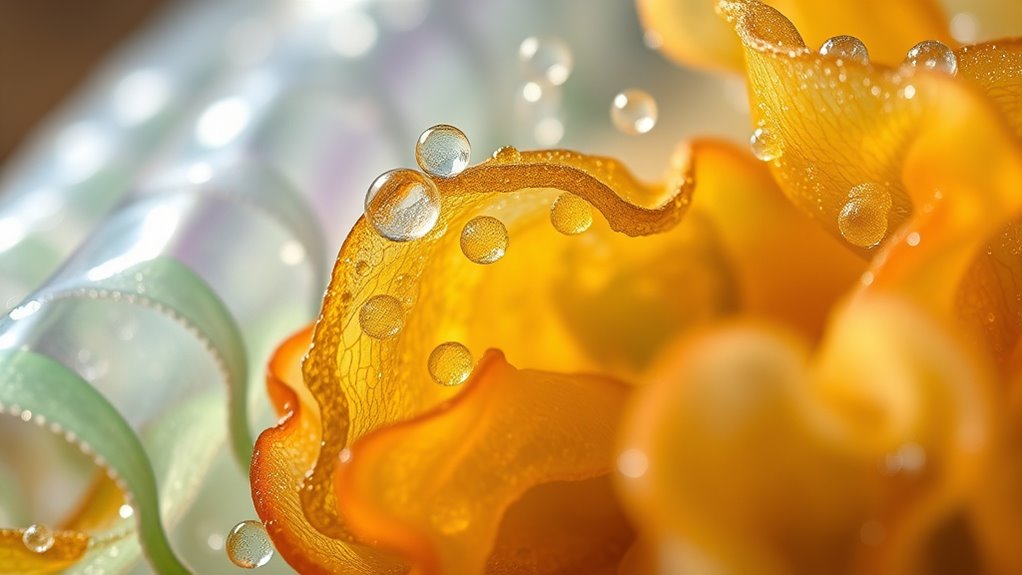
Developing durable edible packaging solutions presents significant challenges due to their inherent fragility and limited resistance to environmental stresses. These materials are more delicate than traditional plastics, offering less protection against physical damage, moisture, and contamination. This fragility restricts their use in long-distance transport and extended storage. Balancing strength with edibility remains a persistent obstacle, requiring advanced material science. Technological complexities involve creating edible films that preserve food quality without sacrificing safety or taste. Additionally, scalability and consistent quality for mass production pose hurdles. Regulatory compliance demands rigorous safety testing, which can delay market entry. Consumer perceptions about cleanliness and edibility further hinder adoption. Addressing these issues requires innovative solutions that enhance durability while maintaining safety and edibility. Ensuring the effectiveness of edible packaging also depends on understanding subtopic 3: Men’s Cologne Recommendations, as the scent and freshness of packaging materials can influence consumer acceptance.
Environmental Benefits and Sustainability Aspects

One of the most compelling advantages of edible packaging is its potential to substantially reduce environmental impact. It cuts waste by being eaten or composted, eliminating the need for recycling or landfills. Since it’s biodegradable, it breaks down into harmless organic compounds, avoiding microplastics and long-lasting waste. Moreover, adopting edible packaging can enhance sustainability practices within supply chains by promoting environmentally responsible material choices. By replacing synthetic plastics, edible packaging decreases plastic pollution in landfills and oceans. Made from renewable resources like seaweed, rice, or beeswax, it lowers the carbon footprint of production and conserves non-renewable resources. This approach aligns with circular economy principles by reducing waste and promoting sustainability. Additionally, edible packaging can extend food freshness, reducing spoilage and food waste. Overall, it offers a greener, eco-friendly alternative that supports environmental preservation and resource conservation.
Future Perspectives and Emerging Technologies
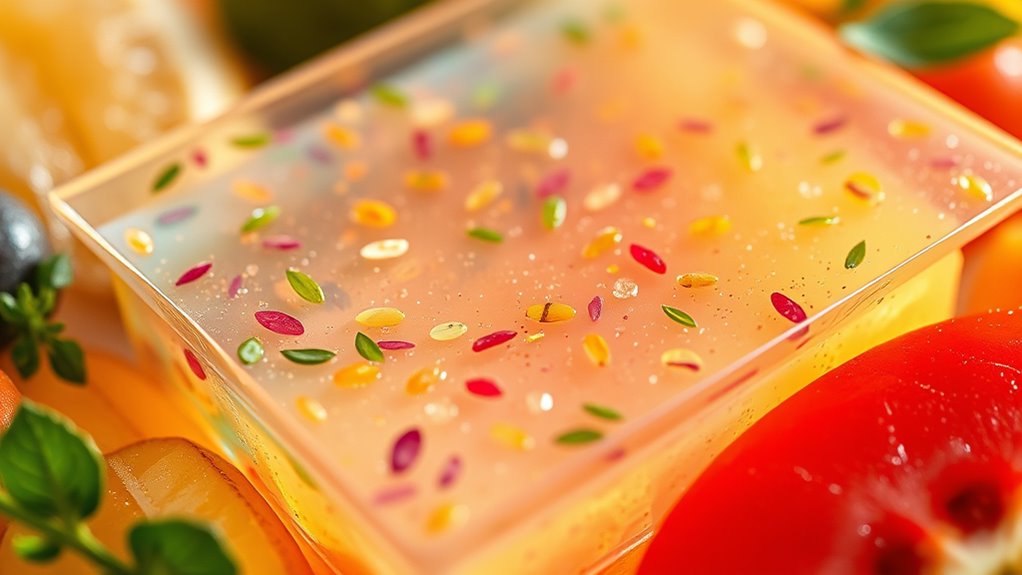
Advances in edible packaging materials and formulations are transforming how we approach sustainability. You’re seeing more natural resources like seaweed, corn starch, and plant proteins used as base materials, making packaging biodegradable and eco-friendly. Researchers are incorporating fruit extracts and edible coatings to boost functionality and visual appeal. Innovations include water-soluble edible pods and sauce sachets that dissolve quickly, reducing waste. Smart technologies are also emerging, embedding sensors that monitor food freshness and communicate with devices, helping cut down food waste. Additionally, the integration of automation in manufacturing can enhance production efficiency and scalability. Manufacturing processes are becoming more scalable, cost-effective, and eco-conscious, enabling broader adoption. Stronger safety regulations and standardization are building consumer trust. As these technologies mature, you’ll notice more sustainable, interactive, and versatile edible packaging options in everyday products, aligning convenience with environmental responsibility.
Frequently Asked Questions
How Do Edible Packaging Materials Affect Food Flavor and Aroma?
You might wonder how edible packaging influences food flavor and aroma. It can absorb or retain specific flavor compounds, sometimes altering the original profile.
The material’s permeability controls gas and moisture transfer, impacting flavor preservation. Properly selected, it enhances sensory qualities and maintains aroma.
But if not designed well, it could absorb unwanted flavors or compromise taste. Overall, edible packaging plays a vital role in preserving and possibly enhancing your food’s flavor and aroma.
Are There Any Health Risks Associated With Consuming Edible Packaging?
Thinking about eating packaging might feel like biting into a mystery novel, but it’s essential to know the risks. You could encounter chemical leaching from additives or preservatives, especially with high temperatures or fatty foods, which might disrupt your hormones or cause toxicity.
Allergens from proteins or cross-contact are also concerns. While innovation aims to minimize risks, long-term safety data remains limited, so stay informed and cautious.
What Are the Ideal Storage Conditions for Edible Packaging Materials?
You should store edible packaging in a cool, dark place at around 25°C or lower to slow degradation. Keep humidity low and use airtight, moisture-resistant containers to prevent moisture absorption.
Protect it from light and oxygen by using opaque, sealed packages. Maintain hygiene by avoiding contamination, and store away from high temperatures above 35-40°C.
Consistent, ideal conditions help preserve its quality, safety, and shelf life effectively.
Can Edible Packaging Be Customized for Different Food Types?
Like a tailor fitting a suit, you can customize edible packaging for different foods. You choose materials like casein for moisture-sensitive items, starch for dry goods, or lipids for oily foods.
You can also adjust thickness, flavor, and barrier properties to suit each product’s needs. This guarantees freshness, enhances appeal, and meets safety standards, making your packaging both functional and delightful for any food type.
How Does the Cost of Edible Packaging Compare to Traditional Packaging?
You’ll find that edible packaging costs more than traditional options because of higher raw material prices, complex production processes, and limited economies of scale.
While the initial investment is steep, it offers long-term benefits like reducing waste and environmental impact.
As technology advances and demand grows, these costs may decrease, making edible packaging more competitive and appealing for eco-conscious consumers and industries.
Conclusion
As you explore edible packaging’s chemistry, remember it balances innovation with sustainability. While these solutions promise reduced waste and enhanced preservation, challenges like durability and scalability remain. You see, the strength of these materials lies in their complex components—yet their fragility highlights the delicate tension between nature and technology. Embracing this duality, you can help shape a future where convenience and environmental responsibility coexist, redefining the way we protect and enjoy our food.
